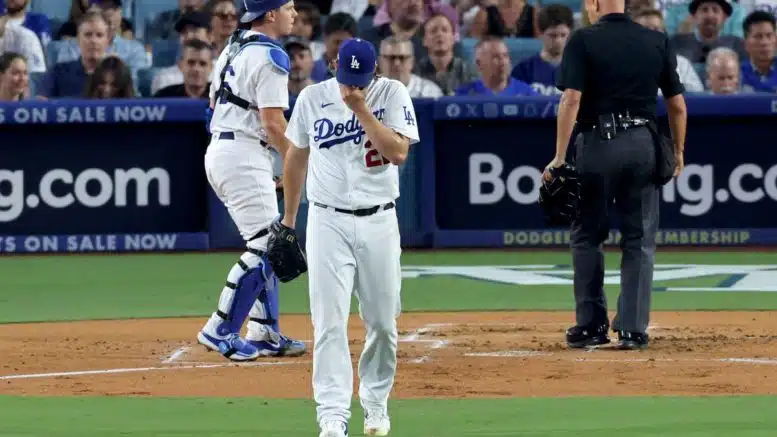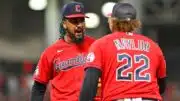Clayton Kershaw is the best pitcher of the 21st century. This much isn’t really in dispute. A career 2.48 ERA and 2.82 FIP over 16 years is unimpeachable. There’s three Cy Youngs to go with it, and an MVP in 2014 when he had a 1.77 ERA and a 0.857 WHIP, which is beyond stupid. He probably should have one or two more Cy Youngs, had the voters not gotten fascinated by the very idea of giving one to a knuckleball pitcher (R.A. Dickey on the east coast).
And Kershaw has been able to reinvent himself a couple times, first arriving with a piledriver fastball and a magic curveball, and eventually shaping that curve into an unhittable slider and working around his diminishing velocity. These days at 35 he relies on location and guile, though the walks have ballooned.
Perhaps he should have been born about 20 years earlier.
Had Kershaw pitched during the limited playoff system, with only division winners and LCSs and World Series to worry about, what he did in the postseason would be something of a footnote. Had he pitched before the Dodgers became a monopoly of the NL West, he probably wouldn’t have that many postseason starts to even consider.
But he didn’t, he wasn’t, and he is here now. And Kershaw getting paddled around in the postseason is, sadly, going to be just as prevalent of an image of his career as all those regular season starts when no one could touch him.
Kershaw gave up five runs last night before he got an out against Arizona. He gave up six in total before being removed with only 1/27th of the outs required on the board. It puts yet another stellar Dodgers season up against it, as they’ll have to find two wins in three starts from Arizona’s top two starters of Zac Gallen and Merrill Kelly (who got the win last night). And the Dodgers don’t really have any trusted starters behind Kershaw. They’ll be making it up as they go with Bobby Miller, Ryan Pepiot, and Lance Lynn probably only going once through a lineup and then an army of relievers. Maybe Kershaw did them a favor in getting beaten so badly that they didn’t really have to go to any of their top relievers, who’ll get a bonus day of rest today.
It’s not that there haven’t been brilliant Kershaw starts in October. There’s been a number of them. 10, in fact, of starts where he went more than six inning and gave up less than three runs, going beyond the definition of a quality start.
But he’s also been shelled equally. Eight starts where he’s given up five runs or more (though one was that infamous Game 5 in Houston when the Astros, by some miracle, never swung and missed at any of his breaking pitches). Sure, there’s been his heavy usage by Dave Roberts, going on short rest or coming out of the pen or sometimes both. But the runs given up are the runs given up by now.
Kershaw is a victim of how baseball is viewed now as well. With the Dodgers turning the regular season into something of a procession, and the expanded playoffs making it easier to do so, the postseason is weighted more. Nothing really matters until October, at least for teams like the Dodgers or Astros or Atlanta now. That’s how MLB wants it. It’s the NBA-ification of the league, despite being a completely different sport.
Kershaw will always run up against the image of Justin Verlander, who is his only competition of pitcher of this century. We have images of Verlander winning series for the Tigers on his own (usually against the A’s). He has two rings from normal World Series, not the one-in-a-can that was 2020. Verlander’s numbers aren’t really that much better in the postseason. He’s got a 5.64 ERA in nine World Series starts. Kershaw’s is 4.46. But Verlander has been brilliant, for the most part, in the Division Series and the ALCS (2.86 and 3.01 ERA).
What’s strange about Kershaw’s playoff foibles is the peripheral numbers aren’t all that different. He strikes out 27.6 percent of the hitters in the regular season, and 27 percent in the postseason. 6.3 and 6.5 percent are his walk rates. WHIP is 1.00 in the regular season, and 1.11 in the postseason.
What changes is how often the runners he lets on score. He leaves 79.6 percent of them on base in the regular season. That plummets to 66.3 in October. He gets eaten by sequencing, and sequencing against the best hitters locked in to their highest degree.
But those numbers won’t erase the blemish. If the Dodgers exit at this stage to a pretty middling Diamondbacks team, and this is Kershaw’s last season, and the Dodgers only have that one half- or quarter-World Series win for their decade of putting tire tracks on the NL West and the National League as a whole, the lasting image will be all the times Kershaw looked behind him in the playoffs to see a baseball landing somewhere where a teammate wasn’t. There are no caveats, or buts, or exceptions anymore.
Follow Sam on Twitter @Felsgate and on Bluesky @felsgate.bsky.social
Original source here
#part #Clayton #Kershaws #legacy





